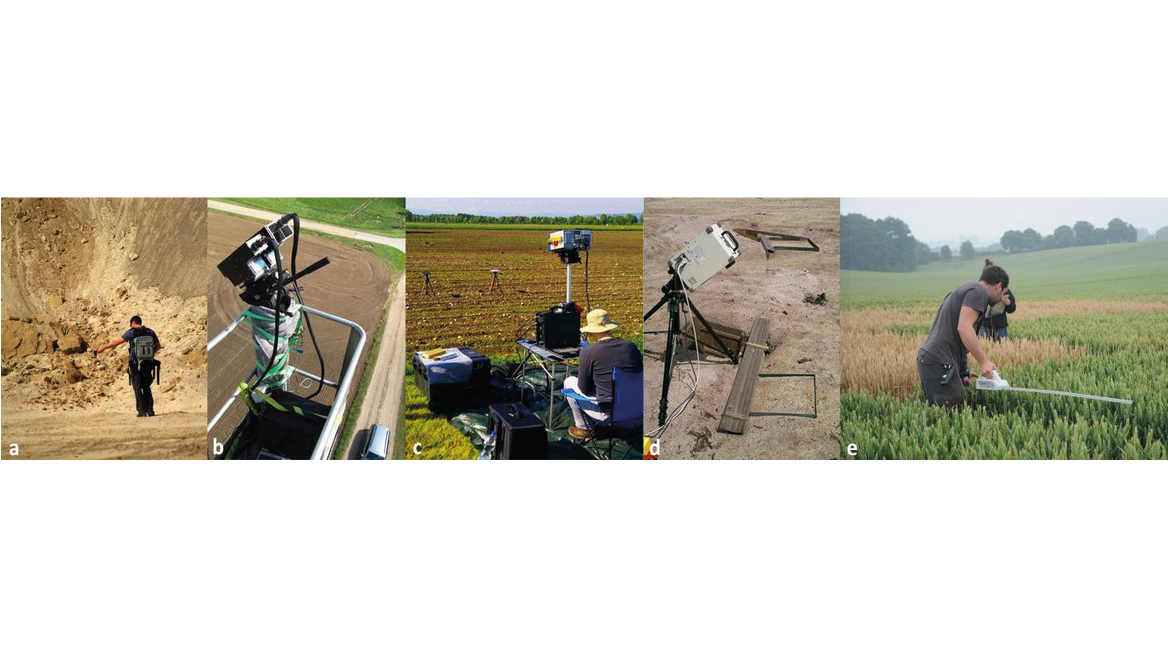Spectroscopy Laboratory
Contact:
Web:
Infrastructure belongs to:
The GFZ spectroscopy laboratory supports advances in optical and thermal remote sensing for the definition of new sensors for spaceborne missions, for the development of methodologies toward improved surface properties characterization, and for the development of standards and protocols. We are focusing on the geosphere applications (minerals and soils), agricultural areas, and arid regions of the world (deserts, arctic) that are subject to erosion and degradation under climate change.
Categories
Disciplinary Keywords
- Fourier Transform Infrared Spectroscopy
- Remote Sensing
- Spectroradiometry
- UV-VIS-NIR Spectrophotometry
- X-Ray Fluorescence Spectroscopy
Selected infrastructures
Instrumentation
Laboratory instrumentation
Instruments
-
Field Spectroradiometer
A spectroradiometer is an instrument for measuring the energy distribution of emitted radiation. Portable spectroradiometers provide field measurements for a variety of applications including geological remote sensing, ground truthing, spectral remote sensing, environmental and climate research, crop and soil research, vegetative studies, forestry and canopy studies, radiometric calibration transfer, upwelling and downwelling measurement.
-
Fourier Transform Infrared Spectrometer
FTIR Spectrometer - Fourier Transform Infrared Spectrometer
Traditional (dispersive) infrared techniques experience difficulties due to the '1 wavenumber at a time' nature of data acquisition. This leads to either a poor signal to noise ratio in a spectrum or a very long time needed to obtain a high quality spectrum. Both these situations cause problems with kinetic work. The first gives inherent large errors, the second prohibits in-situ work. These problems can be overcome using Fourier transform infrared spectroscopy (FT-IR) that is based on the interferometer originally designed by Michelson and a mathematical procedure developed by Fourier that converts response from the 'time' to the 'frequency' domain.
In the Michelson interferometer a parallel, polychromatic beam of radiation from a source (A) is directed to a beam splitter (B), made from an infrared transparent material, such as KBr. The beam splitter reflects approximately half of the light to a mirror, known as the fixed mirror (C), which in turn reflects the light back to the beam splitter. The rest of the light passes through to a mirror, moving continuously, at a known velocity, back and forth along the direction of the incoming light and this is known as the moving mirror (D). Upon reflection from the moving mirror, radiation is then directed back to the beam splitter. At the beam splitter some of the light that has been reflected from the fixed mirror combines with light reflected from the moving mirror and is directed towards the sample. After passing through the sample (E) the radiation is focused onto the detector (F). The detectors are sufficiently fast to cope with time domain signal changes from the modulatio n in the interferometer. Additional information available at http://physics.nist.gov/Divisions/Div842/Gp1/fts_intro.html (Source: Global Change Master Directory (GCMD). 2023. GCMD Keywords, Version 16.3. Greenbelt, MD: Earth Science Data and Information System, Earth Science Projects pision, Goddard Space Flight Center (GSFC) National Aeronautics and Space Administration (NASA). URL (GCMD Keyword Forum Page): https://forum.earthdata.nasa.gov/app.php/tag/GCMD+Keywords)
-
Hyperspectral Camera
-
UV-VIS-NIR Spectrophotometer
-
X-Ray Fluorescence Spectrometer
X-Ray Fluorescence spectrometer (XRF: Primary X-Rays are used to excite (fluoresce) X-rays in the specimen. A fused disc or pressed pellet is used for the determination of major element concentrations or trace element abundances in a bulk specimen. The X-ray detector utilizes a set of diffracting crystals specially positioned to detect one characteristic X-ray at-a-time. This sequential measurement of X-rays is termed Wavelength Dispersive Spectroscopy (WDS). Additional information available at "http://www.nmnh.si.edu/minsci/labs/xrf.htm" (Source: Global Change Master Directory (GCMD). 2023. GCMD Keywords, Version 16.3. Greenbelt, MD: Earth Science Data and Information System, Earth Science Projects pision, Goddard Space Flight Center (GSFC) National Aeronautics and Space Administration (NASA). URL (GCMD Keyword Forum Page): https://forum.earthdata.nasa.gov/app.php/tag/GCMD+Keywords)
Links
Key Publication
- Chabrillat, S., et al. (2019): Preparing a soil spectral library using the Internal Soil Standard (ISS) method: Influence of extreme different humidity laboratory conditions. - Geoderma, 355, 113855.13
- Milewski, R., et al. (2019): Assessment of the 1.75 μm absorption feature for gypsum estimation using laboratory, air- and spaceborne hyperspectral sensors. - International Journal of Applied Earth Observation and Geoinformation, 77, 69-83.

